At home in our house and a sod at that! ... It is not quite so convenient as a nice frame, but I would as soon live in it as the cabins I have lived in... It looks real well.
-- Mattie Oblinger, May 19, 1873, from American Memory
Mattie Oblinger's letter from the Nebraska frontier conveys the pride American settlers felt for the sod houses that became an emblem of their pioneer spirit. In this lesson, students examine photographs of sod houses, build a model sod house, and picture themselves living in a "soddie" to gain a firsthand perspective on this important period of American history.
Guiding Question:
Where did American pioneers live? What did their homes look like? Who built their homes and what materials did they use?
Learning Objectives
After completing this lesson, students will be able to:
- Identify where and when American settlers lived.
- Describe how settlers used available materials to build sod houses.
- Explain how sod houses helped settlers adapt to the environment of the plains.
- Compare living in a sod house with life in a typical home today.
Preparing to Teach this Lesson
1
This lesson plan consists of four learning activities that
you can use together as a unit or adapt separately to your
curricular needs.
2
Review the suggested activities, then download and duplicate
any online materials you will need. If desired, you can bookmark
specific web pages so that students can access relevant online
materials directly. (See Selected EDSITEment
Websites for a guide to locating online materials.)
3
Plan to present the lesson in a rich historical context by providing students with background information from these EDSITEment resources:
4
To help students analyze the archival photographs used in
this lesson, you may wish to adapt the Photograph
Analysis Worksheet available at The
Digital Classroom.
Suggested Activities
Designing a Home
Sodbusters and Their Homes
Exploring Sod Houses
Make Your Own Soddie
Designing a Home
Begin by connecting this lesson to the broad topic of "Home." Ask students to describe some of the different kinds of homes they are familiar with (e.g., frame houses, apartment houses, mobile homes, house boats, castles, igloos, teepees, haciendas, log cabins, etc.). Draw simple pictures on the chalkboard to help students visualize each type of home and talk about some of the reasons for their differences. Use this discussion to lay the groundwork for study of sod houses by helping students recognize that all homes reflect both environmental factors (e.g., available materials, terrain, climate) and cultural factors (e.g., family structure, economics of the community, social status, aesthetic traditions, etc.) Arrange with your school librarian to set out books and magazines that illustrate different types of homes, and encourage students to explore this topic further.
For older students, already familiar with United States history and geography, you might begin the lesson by having them imagine themselves arriving on the Great Plains during the pioneer era and faced with the task of building a home. What kinds of materials are available? What kind of shelter would one need in this environment? How would the size and make-up of your family influence your home-building? How would your plans for making a living -- for example, as a farmer, a teacher, or a storekeeper -- influence how and where you build? What ideas about the look and layout of a home would you be likely to bring with you as a guide to what you should build? Through questions like these, guide students toward an awareness of the environmental and cultural factors they will see reflected in the sod house.
Sodbusters and Their Homes
Provide students with a selection of photographs showing settlers posed alongside their sod houses, choosing from those available through EDSITEment:
- The most famous images of sodbusters are those taken by Solomon Butcher in Custer County, Nebraska, during the 1880s. An emigrant to the region who found that he had no talent for farming, Butcher became an itinerant photographer whose pictures provide us with unmatched documentary record of a unique period in American history. Two of Butchers best-known images are:

The Kern family seated in front of their sod house in 1886, holding slices of an enormous melon as if to show off their prosperity and the bounty of their land. (Courtesy Nebraska State Historical Society [Digital ID nbhips 10026].)
|
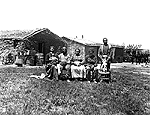
The Shores family, one of the African-American families that came to settle on the Great Plains, whose formal pose, with their sod house and other possessions displayed behind them, conveys a strong sense of accomplishment and determination to stay on their own land. (Courtesy Nebraska State Historical Society [Digital ID nbhips 10527].)
|
- More striking, and probably more immediately appealing to young students, are the hand-tinted photographs of North Dakota sodbusters collected by Fred Hultstrand in the early 20th century. Click "sod homes" on the homepage of this collection for links to hundreds of images, including sod barns, sod schools, and even a sod hotel. For the most part, these are much more modest structures than those photographed by Butcher, one-room dwellings that sometimes seem nothing more than organized piles of dirt. Seeing these houses in color, the dark gray of their dried-earth walls contrasting sharply with the boundless sky and prairie, can help students appreciate the challenges of the plains environment and help them recognize that, as much as it might seem to resemble a conventional house, a sod house was a unique construction and living in one a unique experience. Suggested images for study include:
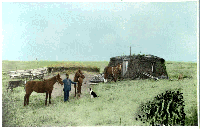
A Pioneer Settler of the "Old West," which shows a man posing proudly on his well-stocked homestead, with his hut-shaped sod house in the background. (Reproduction No. 2028.260, courtesy The Fred Hultstrand History in Pictures Collection, North Dakota Institute for Regional Studies, NDSU, Fargo, ND.)
|
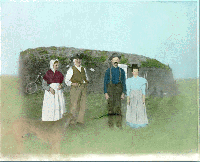
O Give Me a Home Where the Buffalo Roam, which shows an older and a younger couple posed in front of a sod house with a bicycle leaning against it. (Reproduction No. 2028.026, courtesy The Fred Hultstrand History in Pictures Collection, North Dakota Institute for Regional Studies, NDSU, Fargo, ND.)
|
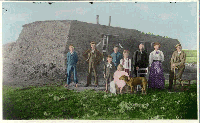
Raising a Fine Family of Pioneers, which shows a family of ten dressed in their best and posed in front of their almost windowless sod house. (Reproduction No. 2028.108, courtesy The Fred Hultstrand History in Pictures Collection, North Dakota Institute for Regional Studies, NDSU, Fargo, ND.)
|
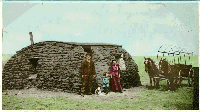
Mr. and Mrs. David Vincent and Daughter, Martha, which shows a young family, also dressed in their best, posing with their horses in front of their sod house. (Reproduction No. 2028.007, courtesy The Fred Hultstrand History in Pictures Collection, North Dakota Institute for Regional Studies, NDSU, Fargo, ND.)
|
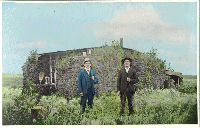
Waiting for the Right Girls to Come Along, which shows two young men posing stylishly in front of a somewhat overgrown sod house. (Reproduction No. 2028.110, courtesy The Fred Hultstrand History in Pictures Collection, North Dakota Institute for Regional Studies, NDSU, Fargo, ND.)
|
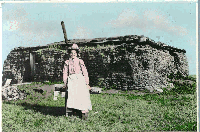
I Loved a Lassie as Fair as Can Be, which shows a young woman in a pink dress and bonnet smiling for the photographer in front of her sod house. (Reproduction No. 2028.050, courtesy The Fred Hultstrand History in Pictures Collection, North Dakota Institute for Regional Studies, NDSU, Fargo, ND.)
|
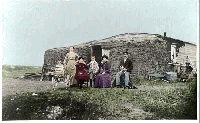
All the Comforts of the Waldorf Astoria, which shows an elegantly dressed family posing in front of a sod house that has gained a wood-frame addition in the rear. (Reproduction No. 2028.105, courtesy The Fred Hultstrand History in Pictures Collection, North Dakota Institute for Regional Studies, NDSU, Fargo, ND.)
|
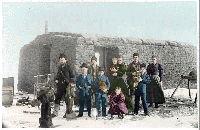
A Visit from the Neighbors, which shows a group of parents and children posing in winter in front of a sod house. (Reproduction No. 2028.094, courtesy The Fred Hultstrand History in Pictures Collection, North Dakota Institute for Regional Studies, NDSU, Fargo, ND.)
|
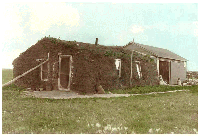 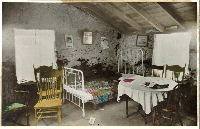
Exterior and Interior of Elling Ohnstad Sod House, photographed in 1923, showing how settlers smoothed and whitewashed the interior walls of sod houses and fitted them for comfortable living. (Reproduction No. 2028.078 and 2028.075, courtesy The Fred Hultstrand History in Pictures Collection, North Dakota Institute for Regional Studies, NDSU, Fargo, ND.)
|
Exploring Sod Houses
Guide students through an analysis of these primary source documents of pioneer life by focusing on one or two images in a class discussion, using the talking points below. For older students, you might prepare a worksheet based on these points (and the Photograph Analysis Worksheet available at The Digital Classroom) which they can use to examine a set of images on their own in small groups.
- What features make a sod house look like a regular house?
Students should notice that sod houses have doorways and windows, stovepipe chimneys, in some cases peaked roofs, and are usually surrounded by a yard. You might point out to older students that most of these features are functional, not simply attempts to "make the house look like home."
- What features make a sod house look distinctive or unusual?
Students should notice the sod walls and sodded roof, the typically low construction, the isolation of the house on the plains, and in many images the small size of the house compared to the number of people who lived in it. Point out the absence of trees in these images to help students understand why pioneers could not build houses out of wood, and have them think about their experiences with dirt to imagine what it was like to live in a "soddie." For example, what would likely happen to the house in a rainstorm? How effectively would it keep out insects and other pests?
- What can you tell about the people in the picture?
Ask students to describe the people posed in each image. Ask, for example, how are they dressed? Why are they dressed that way? How can you tell what they do for a living? How can you tell what they do for fun? How can you tell their relationship to one another? How do you think they feel about their house and their way of life?
- How can you tell when the picture was taken?
Students should notice, for example, that the people in these pictures live without electricity, without automobiles, even without roads. Clothing styles can also provide a clue to the time period, along with items such as mass-produced furniture, farm implements, and, in one case, a bicycle. Rather than ask students to date these scenes, however, help them recognize details that one could use to assign a date.
- How can you tell where the picture was taken?
Students should notice not only the open plains and endless sky but also the apparent absence of fields, marking this as a frontier area rather than an agricultural area like those we can see today.
- Why do you think this picture was taken?
Help students recognize that these images are portraits made to be passed down in the family and shared with distant relatives to show off the pioneer way of life. They are not the work of a news or documentary photographer attempting to document whatÕs happening out on the plains. We are seeing what the people in these pictures want us to see, and therefore, to some extent, we can see these images as messages from the past, invitations to admire what these people have accomplished and share in their satisfaction.
Make Your Own Soddie
Conclude this discussion by having students create model sod houses based on the images they have analyzed. Have students work in small groups (pioneers cooperated in the construction of real sod houses), providing them with sheets of clay from which they can cut their sods using a ruler or table knife, and with flat craft sticks they can use to frame doors and windows. Historical background on how pioneers built sod houses is available at the "There Are No Renters Here'" exhibit at the Women of the West Museum. But like many pioneers, your students will learn by example, working from a picture of a real sod house to figure out how it was put together. As they work, encourage students to share techniques they develop for keeping walls from collapsing, for making square corners, and for supporting the sod roof.
When they have finished their models (or as an alternative where model-building is impractical), invite students to take another step into the pioneer experience by creating pictures of themselves posed proudly in front of their sod houses. Again, have students base their work on specific archival images, so that this phase of the lesson serves to reinforce your analysis of these images and to sharpen the students' perception of historically significant details. Have students add a message to their picture by writing a caption or a letter (very young students can dictate their message to you) telling a distant relative about life in a sod house on the plains.
Extending the Lesson
Continue your investigation into pioneer life with Laura Ingalls Wilder's Little House on the Prairie stories. A "Laura Ingalls Wilder Teaching Unit," available at the Herbert Hoover Presidential Library and Museum, traces the pioneer experience through specific chapters in Wilder's books and includes downloadable patterns for constructing a pioneer town.
Selected EDSITEment Websites
American Memory
The Digital Classroom
New Perspectives on THE WEST
Women of the West Museum
Standards Alignment
View your state’s standards

















